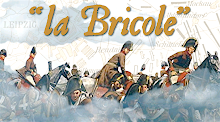A Russian redoubt for my artillery, inspired by-of all things- tofu tubs!
I had been wanting to make some terrain for our Napoleonic games for a while, but hadn't given it all that much thought until yesterday morning when the "Tsarina" was about to toss these into the recycling bin. Small tofu containers that are common in supermarkets here.
I thought that they might come in useful for something, so I rescued them. Having recently finished the licorne, I found myself thinking of how cool it would be to have a small Russian two-gun redoubt ready in time for the next game.
That same evening she went off to an accounting seminar, so I was able to start cutting, planing, and sanding bases without hindrance. After some hot work with saw and glue gun, I was able to knock up the basic shape thus:
I added foam-board chunks for the embrasures and to build up the final shape, and covered all the joints liberally with PVA to anchor everything down.
I'll leave it a day or two to dry out thoroughly, and then cover it with strips of towelling soaked in PVA, filler, and sand. Once that is done I'll add the gabions and any planking, and then texture the whole thing with a coating of my trusty, home-made papier-mâché (a.k.a. "messy but effective gunk") before painting it.
As is the way of such things, I had some substantial cutoffs left over from the MDF board, so I also prepared bases for both a row of houses which will have fenced-off back gardens (I had a bunch of Hovel buildings lying around), and a strip of trees with a hedgerow for pesky voltigeurs to hide behind while taking potshots at us.

I haven't worked much on terrain pieces since my Dolomite fortress, so this will make for a nice little project (and will be easier to store). I've already sent off an order to Front Rank for some more gabion sets. I have a trench work from Kallistra that will make the basis of a much larger redoubt later, but this one will do fine given the number of figures we have ready to go at the moment.
As far as painting goes, I'm finishing up a French 6-pdr. gun and some infantry to clear table space. Then it's on to more Russians, and an additional section of horse artillery (a 6-pdr. this time), so as to have two guns for the redoubt. Not to mention the (tedious) task of removing the flash and casting lines from twenty-four Russian cavalry- the Kharkovski Dragoon Regiment!

























